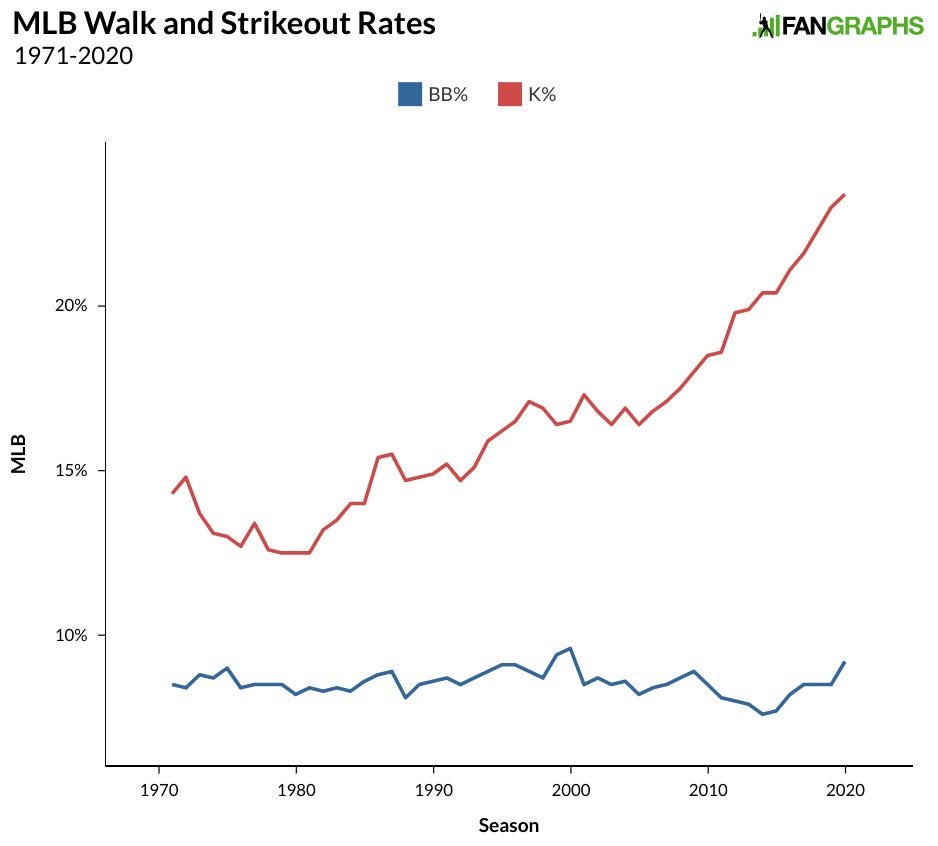It Should Come as No Surprise That FOX News and Its Viewers Don't Care About the Truth
PLUS: How will MLB's new rules change baseball?
If you were enrolled in American Politics 101 at nearly any college or university in the United States, the political science professor teaching that course would offer the following as the main takeaway on the day devoted to a lecture on politics and the media: Rather than the media shaping the behavior of the people, it is the people who shape the behavior of the media.
This runs counter to what most people believe. Most believe the media’s influence over American society is insidious, with journalists and talking heads subtly spinning the days events to advance some sort of political agenda. In this light, journalism is a form of mass manipulation. Mainstream media outlets tow the elite establishment line. Partisan outlets trick unsuspecting Americans into adopting their ideological inclinations.
That’s not really how it works, though. As it turns out, most people consume media they trust, or, in other words, media that reinforces their established beliefs. Liberals watch MSNBC, meaning MSNBC is preaching to its choir. MSNBC doesn’t change people’s minds, because people who aren’t buying what MSNBC is selling aren’t watching MSNBC to begin with.
Media outlets know this, too, and since most media outlets are compelled to turn a profit, they’ll produce content that will retain or expand their audience. It’s the media who adapt themselves to the people, in effect reflecting the views (both ideological and non-ideological) of the people back onto the people. Today’s media universe is big and diverse, and different people may dislike different media, but at the end of the day, an individual consumes the media they want to consume.
For this reason, political scientists don’t tend to focus much on the effects the media have on politics. Again, the media are, for the most part, reflections of the people rather than molders of minds, and there isn’t much evidence to suggest the media change people’s minds. That’s not to say the media aren’t in some ways influential. The media can certainly break new stories and help focus the public’s attention on an issue. Commentators and reporters can help shape public opinion. But the public also has to be receptive to those messages. Thomas Paine’s Common Sense probably did bring some colonialists over to the revolutionary cause, but his pamphlet was likely more useful as a document that crystallized and unified the thoughts of Americans in the 1770s. The pamphlet was titled Common—not Idiosyncratic—Sense for a reason.
As a political scientist who has independently studied politics and the media, I agree with that essential takeaway: That the media shape the behavior of the people far less than the people shape the behavior of the media…to a point. A big factor political scientists tend to overlook is the effect different media formats and economic models of news agencies have not only on the production and consumption of news but the shape of the overall political environment as well. The politics of the network news era vs. the cable news era vs. the social media era will vary because these different media in their own way shape what sort of stories become news and condition consumers to approach the news in unique ways. That’s a story for another day, though.
Let’s stay focused instead on the idea that the media is less a persuasive institution than it is a reflective institution, because a series of bombshell court documents released over the past couple weeks have appeared to demonstrate that truth. A company called Dominion Voting Systems is suing FOX News for defamation, alleging the cable network deliberately spread what they knew to be false claims about the reliability of Dominion’s voting machines and the validity of the 2020 election results in the weeks after Joe Biden had been declared the winner of that contest. Dominion is asking for $1.6 billion in damages.
In the United States, it is very difficult to prove accusations of defamation, and while Dominion has a very compelling case here, they still may not have enough to actually win the day. But let’s set aside those legal issues and focus instead on legal documents from the case, which reveal what was going on behind the scenes at FOX News in the aftermath of the election. It’s pretty damning stuff. Two weeks ago, court filings showed FOX’s biggest on-air personalities—Tucker Carlson, Sean Hannity, and Laura Ingraham—privately told others in the company they did not believe claims of voter fraud levied by people like Donald Trump, Sidney Powell, and Rudy Giuliani during the 2020 election. (“Sidney Powell is lying by the way. I caught her. It’s insane,” Carlson told Ingraham, who responded, “Sidney is a complete nut. No one will work with her. Ditto with Rudy.”) Yet FOX News continued to air the baseless claims. When FOX News reporter Jacqui Heinrich fact-checked a social media message by President Donald Trump and declared on-air there was no evidence Dominion committed voter fraud, Carlson told Hannity and Ingraham in a text, “Please get [Heinrich] fired. It needs to stop immediately, like tonight. It’s measurably hurting the company. The stock price is down. Not a joke,” indicating Carlson felt it was more important to continue to mislead the public, retain viewership, and buttress the value of the company’s stock than it was to get the story right. (Heinrich’s reporting was subsequently removed from social media.) Finally, last week, court documents revealed FOX News’ corporate chairman Rupert Murdoch—who did not subscribe to the allegations of voter fraud—admitted under oath his most prominent news hosts had endorsed the false claim that the 2020 election was stolen and that he could have stopped them but chose not to.
Liberals might reflexively look at that story as proof FOX News is deliberately misleading its viewers, whom they have brainwashed into accepting increasingly outrageous conservative propositions and lies. In other words, that this media company is doing the persuading. But that’s not what’s going on here. What Murdoch and Carlson are really afraid of is losing an audience that wants FOX News to tell them a particular story no matter the veracity of that story. The big wigs at Fox News want FOX News to act as a mirror for the populist conservative movement in the United States. They want to make sure when conservatives tune in to FOX News, that those conservatives see themselves staring back at them. That’s what FOX News viewers want, too.
You could think of it as an act of self-deception. FOX News likes to fancy itself a journalistic institution, but journalism’s primary loyalty is to the truth, and it’s abundantly clear now the truth is not something FOX News prioritizes as an editorial consideration. FOX News and their viewers have no time for the truth and can easily dispense with it when it butts up against their preferred media narrative.
It’s at this point conservatives tend to howl about the liberal bias inherent to left-wing and mainstream media and the lies, spin, deceptions, and mistakes those outlets have used to manipulate the American people. And that’s fine. We can talk about bias and journalistic errors until we’re blue in the face. There are no doubt times when FOX News’ media rivals have gone too far and made mistakes.
But let me say this as well: I see no reason why the journalistic pursuit of the truth cannot be undertaken from a conservative perspective. That’s fine. Just don’t mistake what FOX News does—especially after the revelations of the past two weeks—as conservative “journalism.” Their reporting and commentary is not necessarily accountable to the truth regardless the perspective that truth is viewed from. Furthermore, while their reporting and commentary may align with what many so-called conservatives want FOX News to say, there is nothing “conservative” (let alone journalistic) about pushing a story one knows has no basis in fact.
So what is FOX News up to then? Some have argued it’s a propaganda outlet for the conservative movement. That may be true in some cases; I’m sure there are some conservatives who have started watching FOX News and over time have grown to accept its reportage and commentary as truthful. But FOX News as a propaganda outlet means accepting FOX News is primarily functioning as a persuasive medium when their audience is already overwhelmingly conservative. Maybe their “propaganda” has radicalized their audience, but I would say there is something more going on here than a persuasive undertaking.
Let’s get a couple things about FOX News out of the way. First, FOX News is conservative candy, a cable channel that satisfies the sweet tooth of politically-engaged conservatives. Secondly, watching FOX News allows conservatives to identify as conservatives. It’s like being a Chicago Cubs fan. Anybody can say they’re a Cubs fan. But if you really to to prove to yourself and others that you’re a Cubs fan, you wear a Cubs cap, watch Cubs games, go to Wrigley Field when you can, and vote for Cubs on your All-Star ballot. It’s not enough to declare one’s fandom; for many, they need to act on it to make it official.
But beyond those point and the less-than-convincing argument that FOX News is in the business of persuading people to accept the conservative viewpoint, I think it’s most accurate to think of FOX News as a massive messaging operation. FOX News isn’t trying to convince its audience what to believe; they’re distributing the talking points. Conservatives tune in to learn what to say, how to synch-up their arguments, and stick it to the libs. Rather than think of what FOX News is doing as indoctrinating the choir, think of it more as defining the doctrine for millions of preachers eager to spread the word.
Make no mistake: Many liberals consume liberal media for the same reason. But FOX News and the rest of the conservative media ecosystem operates at a completely different order of magnitude. Why is this? In part, it’s because the conservative coalition is less diverse than the liberal coalition and therefore easier to get on the same page. But it’s also because conservatives feel besieged and have concluded there is strength in numbers. That strength can be magnified through message unity and message discipline. There is a feeling in conservative circles that the day can be won from the national all the way down to the local level if the politically-engaged among them rally around a message that unifies and excites the conservative base, strikes a stark contrast with liberals, and is tailored for optimal political effect. It is FOX News’ job to develop and disseminate that message to an army of conservatives eager to use it as a bludgeon. It doesn’t ultimately matter if that message—that the president was born in Kenya, that global warming is a hoax, that vaccines are harmful, that the election was stolen—is false or even if FOX News and their viewers know it’s false. What matters is that enough people aligned with the conservative movement push it so that the rest of the political world must reckon with and accommodate it.
What the FOX News Nation is doing is beyond mere spin or bias, both of which depend (however outrageously at times) on interpretations of fact. Having discovered that they together as content-generator and content-consumer can will their political impulses into existence, FOX News and their viewers instead treat politics as a war over framing and messaging. Political battles are won or lost in the court of public perception, not necessarily in reference to reality. Whether the economy is good or bad, whether or not there is a pandemic, whether or not election results are accurate is all a state of [the hive] mind. It’s a post-modern form of majoritarian politics, one in which a numerically large group of people have concluded they have the power and means to conjure up an elephant everyone else in the room must address.
Politics is in many ways an imaginative undertaking. Change doesn’t happen until someone imagines a world different than the current one and begins encouraging others to collectively pursue that change to bring that new world into existence. But reality is a stubborn political constraint, and catastrophe has befallen those who have insisted the wider world treat their fictions as operational fact. For example, Lyndon Johnson did not find his way out of the tunnel by manifesting a light at the end of it; all he got instead were bodies. Reality often catches up to those like LBJ who ignore it, but sometimes not before real damage is done. Insist that an election everyone knows was fair was actually stolen in an attempt to make your preferred alternative outcome a reality and you may just end up destroying the democracy you claim to cherish.
In some ways, this episode reveals Fox News’ underlying weakness. FOX News may be the most-watched cable channel in the nation and command an unrivaled platform in American politics, but it also clearly sees itself at the mercy of its viewers. Once upon a time, FOX News commanded more respect as a clearinghouse for conservative thought. It could survey the conservative movement and bring it all together for its prime time viewers. But that was when politicians had to utilize FOX News to reach the people and viewers primarily trusted its hosts to enforce message discipline.
Twitter—and one Twitter-user in particular—changed that. Once Trump could set the party-line message for the conservativerse, FOX News became a superfluous middle man. Like nearly every other conservative who hoped to retain power and influence within the Republican Party, it had no choice but to echo and amplify his message. If FOX News didn’t, their viewers wouldn’t see themselves reflected in FOX News’ coverage, which is what they want to watch. If Trump told FOX News to jump, they’d ask “how high?” And we now know if Trump said he won the election, FOX News’ hosts (despite knowing better) would tell their viewers he was right. That’s weakness. It’s also cowardly and dangerous.
FOX News’ is now apparently trying to shun Trump. Maybe that’s to avoid appearing too cozy with the man during a lawsuit that could cost their company $1.6 billion. Or maybe Murdoch has concluded Trump is a losing proposition and wants to move on from him to DeSantis without inflaming the former president. So how is that going?
And that diner is in DeSantis’s old neighborhood. It won’t be long before FOX News gets back to boosting Trump’s talking points yet again. Does it matter if what Trump says is false? Of course not, so long as everyone is on the same page and using that message to fight like hell against the dying of the MAGA light. FOX News and their viewers wouldn’t have it any other way.
Intermission: “Love the Way You Lie” by Eminem ft. Rihanna (2010, Recovery)
Signals and Noise
In light of the past two weeks’ stories about FOX News, Democrats are debating whether they should finally cut off all ties to the channel or continue making appearances and spending ad money on the network as a form of counterprogramming.
I wonder if Tucker Carlson checked FOX News’ stock price after he heard this.
Hannah Dreier of the New York Times chronicles the story of migrant children who arrive unaccompanied in the United States and end up working dangerous jobs that violate child labor laws. Her introductory profile tells the story of a 15-year-old working on a conveyor belt in Grand Rapids, Michigan, packaging boxes of Cheerios.
By Paul Waldman and Greg Sargent of the Washington Post: “5 Good Points the Right is Making About the Ohio Train Disaster”
The Washington Post’s fact checker looked at claims the Trump administration rolled-back regulations that led to the train derailment in East Palestine, Ohio, and found nothing the Trump administration did administratively would have prevented that accident from happening. While it is true the Trump administration did not enact the Obama-era rule that would have required trains carrying flammable materials to use an electronically-controlled braking system, that rule would not have applied to the train that derailed in Ohio. However, it’s possible implementation of that rule would have led to widespread adoption of electronic braking systems throughout the rail industry.
Data from Georgia show amateur voter fraud hunters swamped elections officials in 15 counties with 92,000 challenges concerning the legitimacy of voter registrations and only successfully removed 2,208 voters from the voter rolls. The challenges disproportionately targeted young voters and voters of color.
Republican lawmakers are using investigative committees to focus their ire on federal workers.
Rep. Matt Gaetz (R-FL) thought he had stuck it to a Biden administration Defense Department official…until it was pointed out the source of information he was using and had just entered into the record was from a mouthpiece of the Chinese Communist Party. (The exchange begins at around 2:45 in the clip below.)
“Will Republicans honor their campaign commitments to secure the border – yes or no? What I am seeing right now from my Republican colleagues does not give me faith that they will stand up in the breach as did those men who stood on the wall at the Alamo. I am tired of words!”—Rep. Chip Roy (R-TX), excoriating fellow Republicans for pushing back against their party’s tough line on immigration. But if Roy is angry about illegal immigration, he probably should refrain from citing the Battle of the Alamo, which pit the Mexican government against slave-owning immigrants (many of them illegal) from the United States who were angry Mexico had outlawed slavery.
Greg Craig argues in the New York Times the issue isn’t Biden’s age but his successor, leading him to conclude Democratic voters should pick who his vice presidential nominee will be in 2024.
A new FOX News poll has Don Trump leading Ron DeSantis for the GOP nomination 43% to 28%, notable because it’s not even close. Multiple polls have shown Trump getting a bump of support in February.
Florida Governor Ron DeSantis questions US involvement in Ukraine today but supported arming Ukraine as a member of Congress in 2014 after Russia invaded Crimea.
Here’s a picture from Tennessee Governor Bill Lee’s 1977 high school yearbook of Lee dressed as a woman. Lee signed a bill this week that would make drag performances illegal in the state.
The Nevada state Democratic Party—long operated by the Harry Reid political machine—is imploding. (Or not?)
Michael Moritz writes in the New York Times about why many of his fellow Democrats are fed-up with the state of governance in his hometown of San Francisco. (“Causes that [Democrats] have long espoused — respect for human rights, plenty of housing that’s within reach for most people, care for the mentally ill, fair pay, high-quality public education, a dignified retirement — have all been crippled by a small coterie who knows how to bend government to its will.”)
Roni Caryn Rabin of the New York Times looks at a string of maternity ward closures in rural hospitals throughout the country.
Walgreens has decided not to distribute abortion pills in a handful of states where abortion remains legal following threats of legal action from Republican state attorneys general.
Jon Stewart got into over gun rights with Republican Oklahoma State Senator Nathan Dahm. If you don’t have the time to watch it in its entirety, at least cue the clip up to 7:15, when Dahm explains to Stewart why it’s OK to infringe on a drag queen’s free speech rights when it comes to reading stories to children but not on anyone’s Second Amendment rights.
Paul Kane of the Washington Post writes about Mentor of the House Nancy Pelosi.
Average per capita student loan debt is up 2,807% since 1970.
Jeanna Smialek looks at the Federal Reserve and wonders if it wields too much democratically unaccountable power.
Solar energy is set to become the world’s number one source of energy by 2027.
The CIA believes Iran’s nuclear program is advancing at a rapid rate, and while its Supreme Leader has not yet decided to restart its weaponization program, it would only take a matter of weeks for Iran to enrich uranium that could be used in a nuclear weapon.
The CIA also believes China is having second-thoughts about invading Taiwan after watching Russia’s stumble in Ukraine. And that China has not yet committed to sending lethal aid to Russia.
Fareed Zakaria warns in the Washington Post about groupthink when it comes to American policy toward China.
The UK and the EU have agreed to a new deal on Northern Ireland, which resolves the last major outstanding Brexit issue. Hardcore Brexiteers don’t seem happy, but it seems mainstream British politicians are glad to put the matter in their rearview mirrors.
After a Palestinian gunman killed two Israelis, Israeli settlers in the occupied West Bank rampaged through Palestinian towns, setting fire to numerous homes and cars and killing one man.
Nigeria—Africa’s most populous nation and largest economy—held an election last week that could determine the future of its democracy.
Mexican President Andrés Manuel López Obrador has posted an image to Twitter of what he claims is a mystical woodland elf that proves the existence of mischievous Mayan spirits.
The photo, which Obrador said was taken recently, has apparently been circulating on social media for at least two years.
Say what you will about AI, but at least it gave us this: Every American President, but they’re all cool and they all sport a mullet (see Joe Biden below.) Full thread here, story here.
Garbage Time: Pitch Clocks, Bigger Bases, & No More Shifts—How Will MLB’s New Rules Change the Game?
(Garbage Time theme song here)
Baseball is a sport that has a reputation for timelessness. It’s said kids today basically play the same game their parents, grandparents, and great-grandparents played. The style of play may be different, but the rules for the most part have stayed the same.
Yet while baseball certainly has tinkered less with its rules than football and basketball, it can’t be said professional baseball has never adjusted its rule book. Slight changes can make a major difference. Here’s a list of MLB rule changes from over the years. Some of them are fairly minor, but others, such as the ones listed below, have altered the game in significant ways:
In 1903, MLB forbade teams from raising the pitcher’s mound beyond 15 inches. In 1950, the height of the pitcher’s mound was set at 15 inches. In 1969, after a decade of increasingly dominant pitching, the height of the mound was dropped to 10 inches, resulting in significantly more offense.
The sacrifice fly was introduced in 1908, eliminated in 1931, and reinstated in 1954.
The American League adopted the designated hitter in 1973. All of MLB adopted the DH in 2022.
In 1925, MLB determined outfield walls could be no closer to home plate than 250 feet. In 1959, the minimum distance for outfield walls from home plate in all new parks was set at 325-400-325.
The precise dimensions of the strike zone have shifted numerous times over the years.
Instant replay on select plays was introduced in 2008.
Since 1988, MLB has only made five notable adjustments to its rulebook: The aforementioned instant replay rule, the Buster Posey rule (designed to eliminate collisions at the plate), a rule regulating take-out slides on potential double plays, a requirement that relief pitchers face at least three batters, and league-wide adoption of the DH. This season alone, however, MLB is adopting five new rules many believe will dramatically alter the way the game has been played in the modern era:
Bases increase in size from 15x15 inches to 18x18 inches.
Defensive shifts are banned. Two infielders must be on either side of second base when the pitch is released, and all infielders must have their feet in the infield dirt/grass as the pitch is released.
Pitchers will have 15 seconds with the bases empty and 20 seconds with runners on base to start their wind-up. Batters must be ready to hit by the time the pitch clock counts down to 8 seconds.
Pitchers are only allowed to “disengage” from the rubber (i.e., step off, attempt a pickoff) twice per plate appearance. Batters are also limited in how many timeouts they can call during at-bats.
Extra innings will begin with a runner on second base.
Why the changes? A lot of it has to do with the analytics revolution, which itself has dramatically changed the way players and managers have played the game over the past two decades. Managers used to routinely call on players to bunt, steal, and execute hit and run plays. With two strikes, they expected batters to choke up and attempt to slap a ball into play rather than strike out, a shameful outcome. Players were celebrated for finishing the season with high batting averages.
Statistical analyses of the game, however, found those strategies were less than optimal. It didn’t pay to advance a runner an additional base with a bunt if it meant giving the defense a precious out. Stealing was a high-risk/low-reward proposition, even for the speediest of baserunners. Hitting for average was overrated, since the odds of that new baserunner getting turned into an RBI are small. Better, it turned out, to swing for a home run at all times, even with two strikes, even if it meant trading in a potential single for a K. (Unlike a single, a home run is a hit that comes with a run.) Also important: Swinging at strikes (the sort of pitches a hitter can drive) rather than balls. Any little leaguer can tell you that, but according to the logic of analytics, it’s better to strike out swinging for the fences on a strike or not swinging at a ball to pick up a walk than it is to put bat to ball in the hope of collecting a mere base hit. (Last year, only 8 players in the American League and 3 players in the National League hit over .300; thirty years ago, the top ten players in batting average in each league hit over .300.)
Eventually, teams applied analytics to defense as well. Managers could position outfielders almost precisely in the spot where batters were expected to fly-out. Most noticeably, teams employed shifts to stifle hitters, often lining up three infielders on one side of the diamond to snag groundballs. Conditioned as they were to pull pitches for home runs, hitters would almost always try to beat the shift by hitting over it than punch a single into the mostly vacant opposite field (an outcome the defense would regard as positive.) The result was a game noticeably devoid of defensive highlights, since most fielders could now easily make plays on balls hit in their direction.
One reason I love baseball is that it’s an incredibly cerebral game. Athletic skill and good instincts aren’t enough; you need to have brains, too, and all that down time favors smart players who can think their way through the game. Baseball is a sport brimming with information, too. As a kid, I would look at the stats on the backs of baseball cards and wonder if I could somehow simulate a game using that information. (Twelve-year-old me couldn’t figure out how to compare batting average to earned run average, and then, even if I had discovered WHIP, I wouldn’t have known how to work with percentages like that at that age.) That’s part of the reason I’ve always rooted for the analytics crowd, the nerds in front offices who figured out which players played the game in the most optimal way and which strategies could be used to maximize their teams’ chances of winning over the long run. They outsmarted the jocks who were good at baseball but not necessarily good at understanding what really mattered in the game.
But then the analytical Moneyball crowd kind of “solved” baseball, draining the fun out of it. It became very one dimensional—a bunch of one-run home runs—without the flashes of athleticism that made players like Rickey Henderson and Ozzie Smith legends on my little league diamond. After all, as cerebral as the game is, every kid who plays the game dreams of diving for ground balls and stretching singles into extra-base hits. (I still dream of doing that.) Fans don’t visit an MLB ballpark expecting to find a glorified slow-pitch softball game, but that’s often what they end up watching.
So not only has analytics deprived baseball of its athletic drama, but it’s also made it an uglier game. Additionally, the average time it takes to complete games has continued to lengthen over the years. Fifty years ago, it would not have been unusual for a nine-inning game to finish in around two-and-a-half hours. The average game now lasts over three hours. Postseason games always seem to take an interminably long time to complete. Some of this is a matter of analytics, which favors more disciplined batters, which leads to deeper pitch counts. But it’s also a result of batters and pitchers (who are throwing harder than ever) taking a longer time to recover and reset between pitches. No one goes to a baseball game expecting to watch an event as action-packed as an NBA game. Baseball’s slow pace is part of its charm. But a three-and-a-half to four hour game with a bunch of strikeouts, few runners on the base paths, and barely a batted ball that strains a defense just isn’t engaging.
The new rules MLB has adopted are meant to address these problems by speeding up the game and allowing players’ athleticism to shine. But when the season starts in about a month’s time, can we expect these rules to produce those results? Let’s consider them one-by-one.
Bigger bases: Red Sox manager Alex Cora has said the new bases look like “pizza boxes,” although having watched a few innings of spring training games on TV, it’s hard to notice a visual in-game difference. The bigger bases are supposed to encourage players to steal more often: They get an extra three inches on their lead-offs and will reach the next base three inches sooner as well.
I’m skeptical we’ll see a notable increase in stolen bases, however. Those extra six inches may seem like a lot when instant replay reveals how close so many plays at the bag are, but bases are stolen on pitchers and catchers. The speed of the delivery, the speed of the pitch, how cleanly the catcher catches the ball, how quickly the catcher transitions the ball to his throwing hand, the speed of the catcher’s throw, and the accuracy of the catcher’s throw matter more in most cases than the speed of the runner. It’s possible with the shift banned, which should result in more hits, that teams will want to move runners into scoring position more often, leading to more steals, but I suspect managers will still use steals sparingly and only in specific situations. It just isn’t worth the risk. (For reference, an analytics article posted on Bill James Online by Dave Fleming from 2008 notes that, when taking into account times when he was caught stealing, Rickey Henderson’s adventures on the base paths only probably netted his teams 1-2 wins each season when he was in his prime.) Expect to see a few more stolen bases this year on maybe a few more attempts. Also expect to see a few more base hits as a result as well, since the bases are now three inches closer to home plate, too.
Bans on shifts: This rule change will probably have the biggest impact. Batters—especially left-handed batters—will no longer be hitting into a human net on the pull-side of the field, which will result in more base hits. Infielders will be scrambling more to make plays, so expect the return of infield web gems. More baserunners will translate into more action on the base paths. The game will look much more like the game everyone grew up playing. The shortstop will actually be playing the shortstop position (albeit as close to second base against left-handed batters as possible.)
I like the spirit of this rule, but is it actually a good rule? Why shouldn’t defenses be able to shift, since professional baseball has allowed them to do so for 150 years? When I was in little league, we moved an infielder into the outfield one game to keep the opposing team’s best player from smashing inside the park home runs against us. It worked: The kid did hit one home run, but he flew out twice, and his dad was livid with our coach for daring to play the game that way. But so what if we played the game better than our opponent that day? Aren’t there times when it makes sense to shift?
So I would propose changing the rule: In a regular 9-inning game, defenses are allowed to shift…I don’t know, 3, maybe 4 times? Something like that. Teams could decide to shift on one player every time he comes up. Or reserve their shifts for particular situations. Or save them for late-game situations. It would add a bit of extra strategy to the game. Heck, maybe a player who got shifted against would foil it by laying down a bunt in that one circumstance just to make the defense regret the move. I like the return to regular-position baseball, but there has to be some allowance for a shift. (NOTE: It turns out teams have found a loophole in the rule. This past weekend, the Red Sox shifted their left fielder into shallow right field against Minnesota’s left-handed power hitter Joey Gallo, who is definitely only trying to hit home runs.)Limited pick-offs: No one likes pick-off attempts…unless they work. Then they’re cool and very funny. This rule is intended to speed up the game, but I can’t believe a game’s worth of pick-off moves slows down the game that much. Since few runners are running anyway, when pick-off attempts are used, it’s usually for good reason. So more than anything, this rule would seem to work to encourage stealing, since a failed pick-off attempt basically turns on a green light (although it might also herald the return of the pitch-out.) Just wait for that game, though, when a pitcher tries a pick-off then has to step-off on the next pitch because he gets something in his eye.
Runners on second base at the start of extra innings: Baseball purists don’t much like this rule, which is a holdover from the special pandemic rules, but I don’t mind it. It’s fair for both teams and helps prevent marathon games, which lend themselves to good stories but are more often than not miserable affairs to watch. But how about a tweak to the rule: Instead of requiring the last batter from the previous inning to serve as the runner on second base, why not let teams use any player who hasn’t entered the game yet to serve as the baserunner? No one wants to see the catcher who struck out to end the top of the ninth standing on second base to start the top of the tenth, especially when the other team gets to send their shortstop out there. Just put some speed demons out there and let them go wild!
Pitch clocks: This is the most troubling rule. I’m not against speeding up games (I could find MLB an extra 8-10 minutes per game by cutting down the time between innings from 120 seconds to 90 seconds.) I worry high velocity pitchers are going to get hurt, though, although it may also encourage them not to throw as hard. At first, I expect pitchers will have a harder time adjusting to the new pace of the game, but as they get used to it and figure out how to turn it to their advantage, my guess is batters—almost always at the mercy of pitchers—will feel either really rushed or frozen in the batter’s box.
The bigger issue, though, is I just don’t like a clock intruding on a baseball game. I’d prefer a less intrusive way to alter behavior, like issuing warnings to pitchers and batters if they take too long between pitches, or turning the clock on after three innings if the first three innings take longer than an hour to play. I also don’t want to rush the end of a close game, either. Let that chess match play out at its own speed. I’d hate to see a game decided because a batter didn’t step into the batter’s box or a pitcher didn’t start his wind-up soon enough. It would also be lousy if competitive games ended in a rush because players didn’t have enough time to figure out what they were going to do in a particular situation. There has to be a better solution than an omnipresent ticking clock.
In many ways, then, professional baseball this season should more closely resemble the game most adults grew up watching and playing: More brisk, more singles, more base running, more athletic fielding. But in one big way, this leisurely, pastoral game will have changed in a way that fundamentally alters our mental conception of baseball: For the first time, this timeless game will have a timekeeper.














![OC] How the Length of a Baseball Game Has Changed Over 75 Years : r/dataisbeautiful OC] How the Length of a Baseball Game Has Changed Over 75 Years : r/dataisbeautiful](https://substackcdn.com/image/fetch/$s_!t9yA!,w_1456,c_limit,f_auto,q_auto:good,fl_progressive:steep/https%3A%2F%2Fsubstack-post-media.s3.amazonaws.com%2Fpublic%2Fimages%2F0ee130de-1c56-4b5a-8f6d-5243e8735eea_2295x1210.jpeg)
